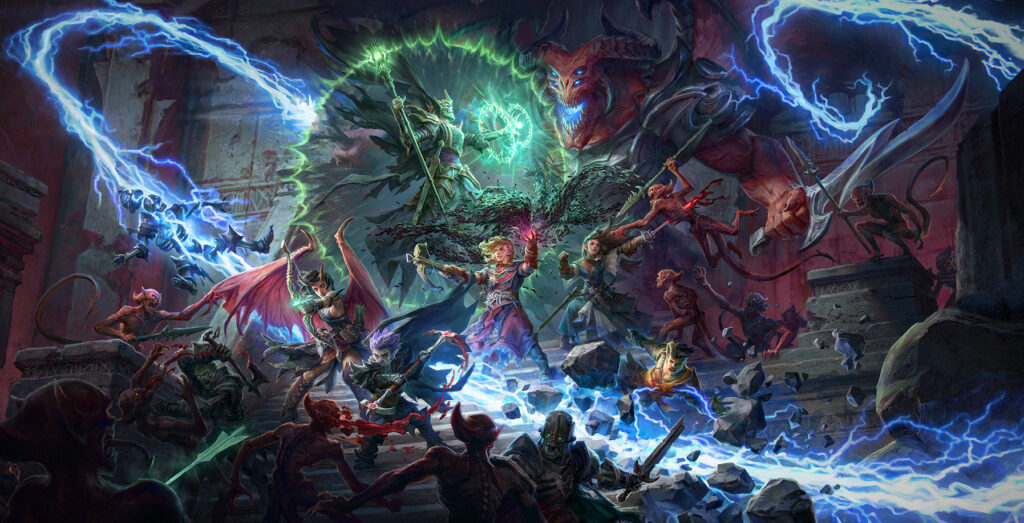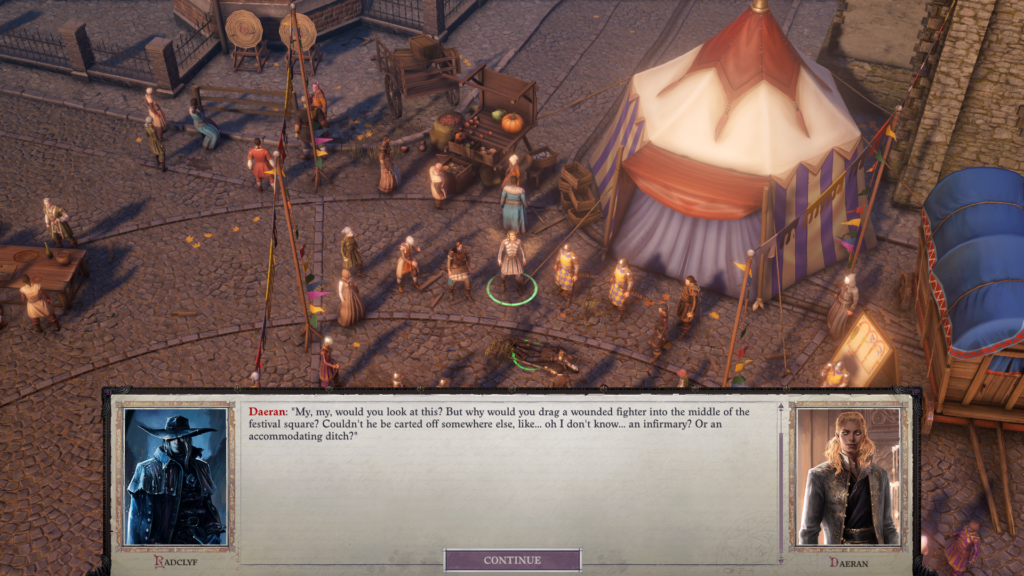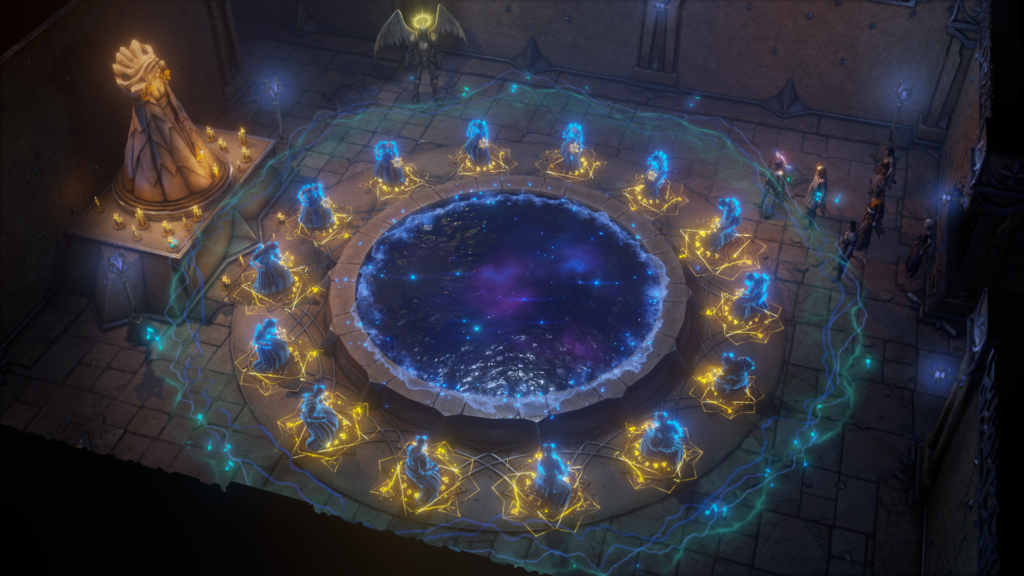
Pathfinder: Wrath of the Righteous is as compelling as it is a slog
Pathfinder: Wrath of the Righteous sees you at the heart of a conflict that, on the surface, seems to be a classic tale of good versus evil. You find yourself leading a crusade against armies of demons, flooding out of the abyss and into your home through a crack in your respective planes called the worldwound. And slowly, as you become more powerful, as the factions of the abyss and the heralds of heaven make themselves known, that binary of good versus evil becomes a little more complex.
The fifth crusade becomes less of a war than it is an intrigue, with major players having their own motivations. Far from a straightforward cleansing of evil, stark revelations unfold and keep unfolding until the last possible moment. You’re far from a neutral party either, as your actions shape the crusade, but also yourself, fundamentally. My crusader became an avenging angel – literally, halo and all – but there was a moment where he nearly became an all-seeing agent of cosmic law, and in another life, that drive for vengeance manifested as something much more demonic.
While the vastness of war breaks down into intrigue, your myriad companions reflect the conflicts of the fifth crusade on an even smaller scale, as they grapple for control over their own destinies. Even when they wear the themes of their arcs on their sleeves – Woljif memorably brings up that he has no birthright and is a product of his circumstances every time you speak to him – they feel like characters with souls, and I wanted to treat them honestly. In the highest praise I can give, I earnestly loved some companions, and was joyfully mean to others. You can’t be friends with everybody.
You can romance a good few of them though. Four of your seven romance options are bisexual, with the remaining three being available to crusaders of only specific genders. There’s no suggestion that sexuality is stigmatised in the setting, which is exemplified in an early moment of the game. Irabeth, the leader of a particular chapter of crusaders is discussing how the crusade was a refuge for her as a half-orc, and the fact that she’s married to another woman is pointedly not an issue. Fantasy racism, yes. Fantasy homophobia, no.

It did create a separate friction, however, at a stage where the conflict feels most Christianised. At a point in the game where the language of holy wars and heaven and templars is particularly present, depicting crusades as a safe space for outsiders created a moment for pause: was this effectively pinkwashing the idea of crusades?
Pathfinder: Wrath of the Righteous does acknowledge the implications of its settings – particularly through your companions. It’s possible to have in your party both a member of an order of militant zealouts, and a child who survived being burnt at the stake by inquisitors. Still, this lingering friction is possibly how I ended up romancing one of my evil companions: Daeran, a debauched snob of a noble, is only slightly less discomfited by the righteousness of the crusaders than he is the evil and chaos of demons. But underneath several layers of deflection and sarcasm, his arc is both a nuanced meditation on autonomy in this good-versus-evil world, and incredibly sweet.
Pathfinder: Wrath of the Righteous is a skillfully written epic – literally, with my playthrough finishing at around 130 hours. It is also deeply, deeply frustrating to play. For every part that I enjoyed, frustrating design and bugs both drew my attention away again. There were two types of notes I took while playing. The first was “I love my evil boyfriend”. The second was “this thing is broken”.
Some performance issues were straightforward stability issues – freezing and crashing between transitions, and lag in major hubs. Others were memorable for being significantly more bizarre. I’d boot up one day, and there would be a texture issue causing everyone’s cloaks to stretch off the screen. On another, I’d find that using any keyboard shortcuts at all forced the window to minimise. In one area, the camera constantly flew away into the distance – and I was only glad that it wasn’t the area where the position of the camera physically dictated the structure of the map, because that didn’t always work smoothly to start with either.

While patches were frequent, these bugs contributed to an experience where the overwhelming impression I had of Pathfinder: Wrath of the Righteous was frustration. Its design tries to keep you engaging in the same activities in a kind of loop – you are not simply going out on quests, but managing a crusade. So where its predecessor Pathfinder: Kingmaker just asked you nicely to come back to your throne once a month, this game coerces you back to your stronghold with an abyssal corruption system.
Should you spend too much time in the worldwound, you accumulate increasing debuffs, similar to a fatigue system. You need to go back to your base to rest somewhere safe – and also, pick up new quests, talk to your companions and advisors, and catch up on the necessary admin of running a crusade. In theory, this admin extends to ‘building other safe places to rest’, but these safe spaces, again, were bugged.
In lieu of pursuing quests, it’s easy to spend hours just doing… stuff. A given quest might be locked behind an area’s fort, which means training up your crusade army – distinct from your own party – to a higher level. Levelling up your army is simply a matter of time (recruitment happens every week) and rolling management events that might increase morale or buff your armies.
So you spend weeks in-game, and hours in real life, waging tactical wars of attrition that mostly boil down to “click on an enemy until he dies” that easily snowball into failure across your entire campaign. These are also often bugged – skills other than straight damage often don’t do anything, with enemies walking straight through traps and control spells having no effect. The option to auto-complete fights is woefully ill-balanced too, forcing you to manually fight every battle. In one instance, it calculated an ‘everyone died, forced retreat’ outcome for a battle I then won in fewer than ten turns without being hit.

This loop – bugged or otherwise – constantly disrupted my engagement with the story. Whenever a questline would reach a new branching point, I would be coerced back to Drezen, for busywork. By the time I head back into the world, I’m staring at a list of ten equally pressing quests – all with red marks next to them for ‘do this now or it will fail!’ Any sense of urgency or direction became waylaid by the admin.
Still, as I work my way through, there are both highly visible life-changing choices, and those so invisible I don’t realise I’ve made them until well afterwards. I find myself thinking about what I want to do differently next time – when I play someone other than a half-vampire angel of death, which is the kind of high concept character only RPGs can give. Underneath the bugs and the slog, I want to know how else it could be. Or, true to the way I play RPGs, maybe I want to romance my evil boyfriend again, but with slightly different dialogue choices.
Score: 3/5
A copy of Pathfinder: Wrath of the Righteous for PC was provided to Gayming Magazine by PR.



